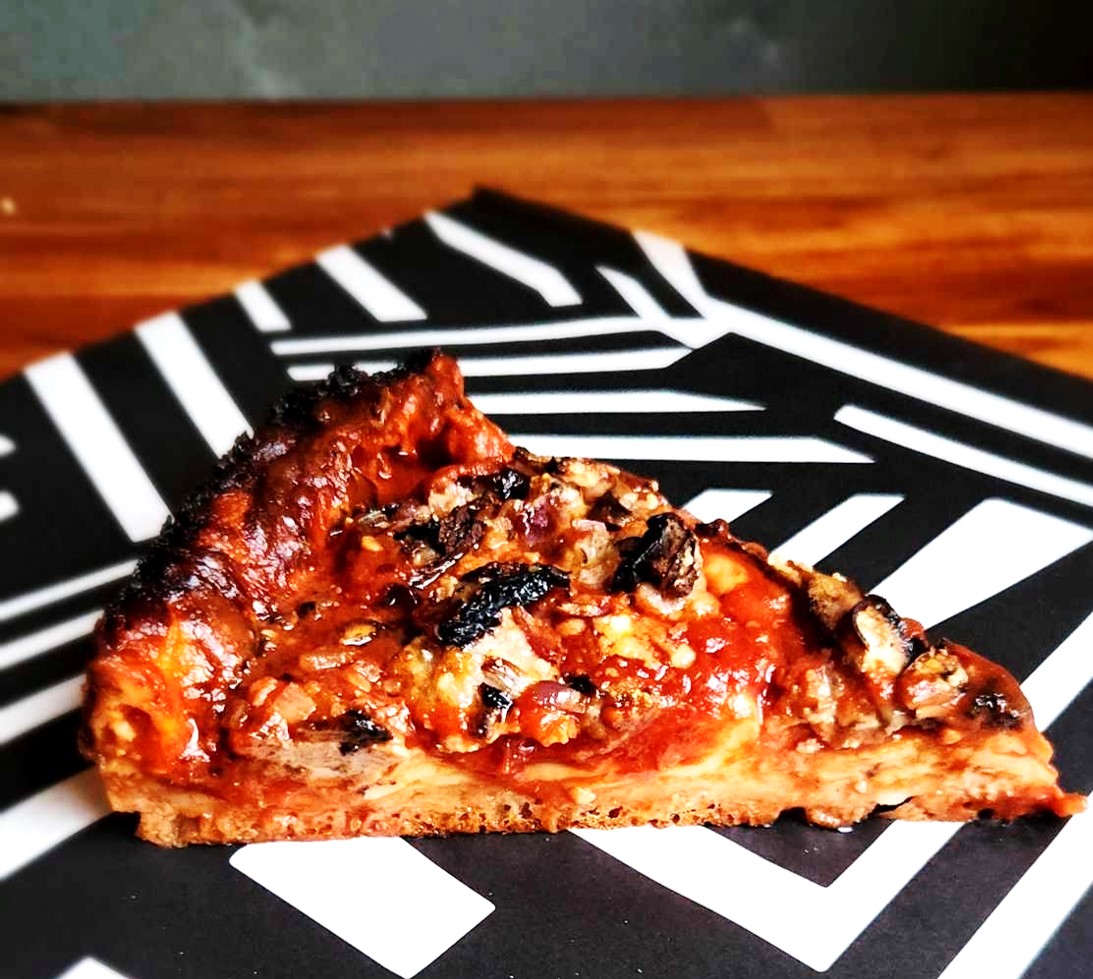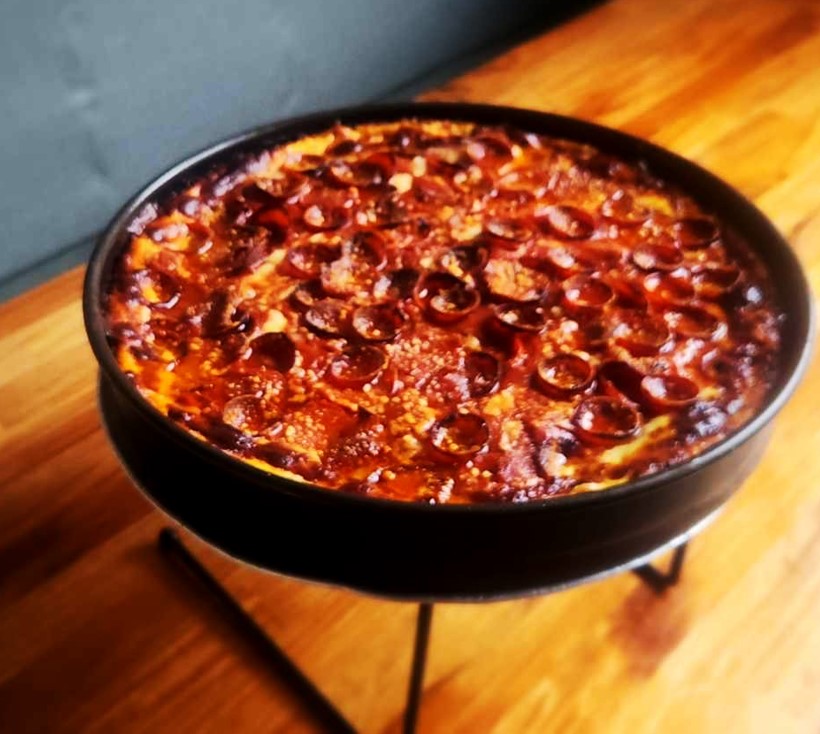The Many Faces of Deep Dish
The Many Faces of Deep Dish
By Chef Paul Kasten
Over decades of studying Chicago's greatest pizza masters (read my complete breakdown in "Mastering Chicago's Deep Dish Legends"), I've learned that deep dish isn't a single style—it's three distinct philosophies of pizza construction, and within each there is variation in terms of ingredients and method. At Deep End Pizza, we honor these traditions, but many guests don't understand why we serve them so differently.
Let me explain the tale of three deep dishes.
I Thought Deep Dish Was Only One Thing!
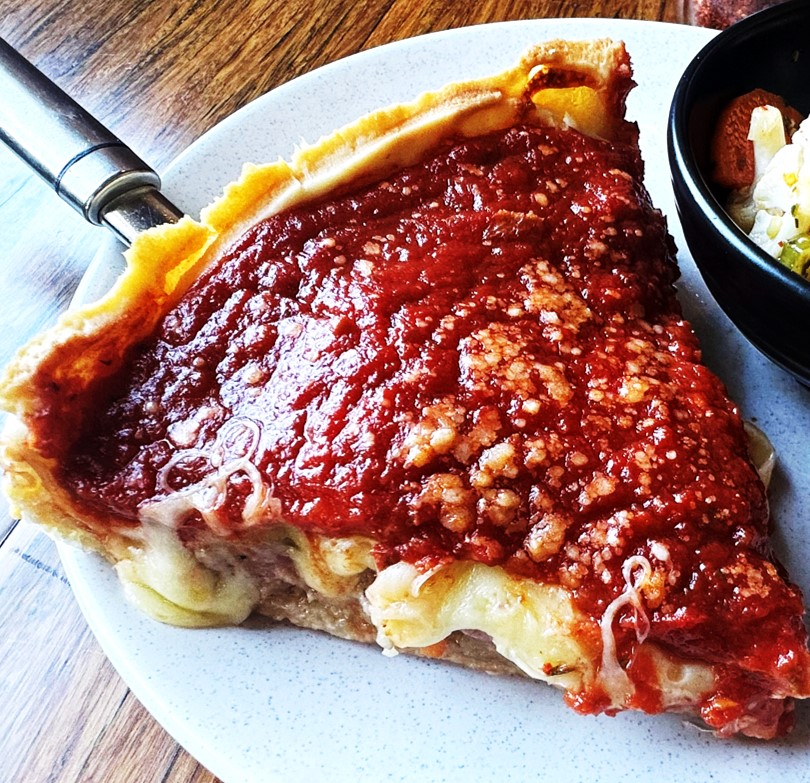
Photo Credit @2goodforks_
Deep dish varies from place to place, just as it does with any other pizza style, but nearly everything out there can be traced back to three distinct lineages.
1. Uno's, Lou Malnati's & Gino's East
Whether there is butter or cornmeal in the crust, or both, these all follow the same basic rules of construction. Dough is pressed up the sides of a pan. Meats are added first, followed by cheese, then vegetables, sauce on top and a sprinkling of pecorino romano.
Check Out Uno's, Lou Malnati's & Gino's East
2. Giordano's & Nancy's
Stuffed pizza starts with a uniform bottom dough laid into the pan followed by meats, vegetables and cheese. A thinner top dough is laid on top and the two doughs are crimped together at the rim of the pan. This is then topped with sauce and a sprinkling of pecorino romano.
Check Out Giordano's & Nancy's
3. Burt's, Pequod's, Inferno's & Gulliver's
Too deep to be pan and too pan to be deep dish. This style starts with a dough pressed flat across the bottom of the pan and allowed to rise. It is then topped with sliced cheese, which runs all the way up the sides of the pan followed by the sauce, with toppings and a sprinkling of pecorino romano on top. The cheese lining the sides of the pan create that famous caramelized crust, cooked so dark it looks like somebody messed up, but always super tasty!
Check Out Burt's, Pequod's, Inferno's & Gulliver's
Technically, this is a pan pizza style, but deeper and more heavily topped than others, so it feels more natural to lump it in with its deep dish cousins than its pan pizza siblings. It gets most of its height from the crust, whereas other deep dish pizzas get their height from piling up the cheese and toppings.
Where Did Deep Dish Come From?
What would later become deep dish was first created by Richard Riccardo at Pizzeria Riccardo on Wabash Avenue, Chicago in 1943, recounted in a Chicago Sun article a few weeks after the pizzeria’s opening.
While this established the roots of the style, it was actually not all that deep. These early pizzas were about half the height of those currently served there.
Lots of other stories have been out there for decades about the origins of the style, but every serious look into the matter has knocked those down as marketing spin.
In 1955, after Riccardo’s death, his business partner Ike Sewell renamed the restaurant Pizzeria Uno when due to demand, he opened Pizzeria Due just a block north. Sewell would go on to basically write his former partner out of the history books and market himself as the creator of deep dish.
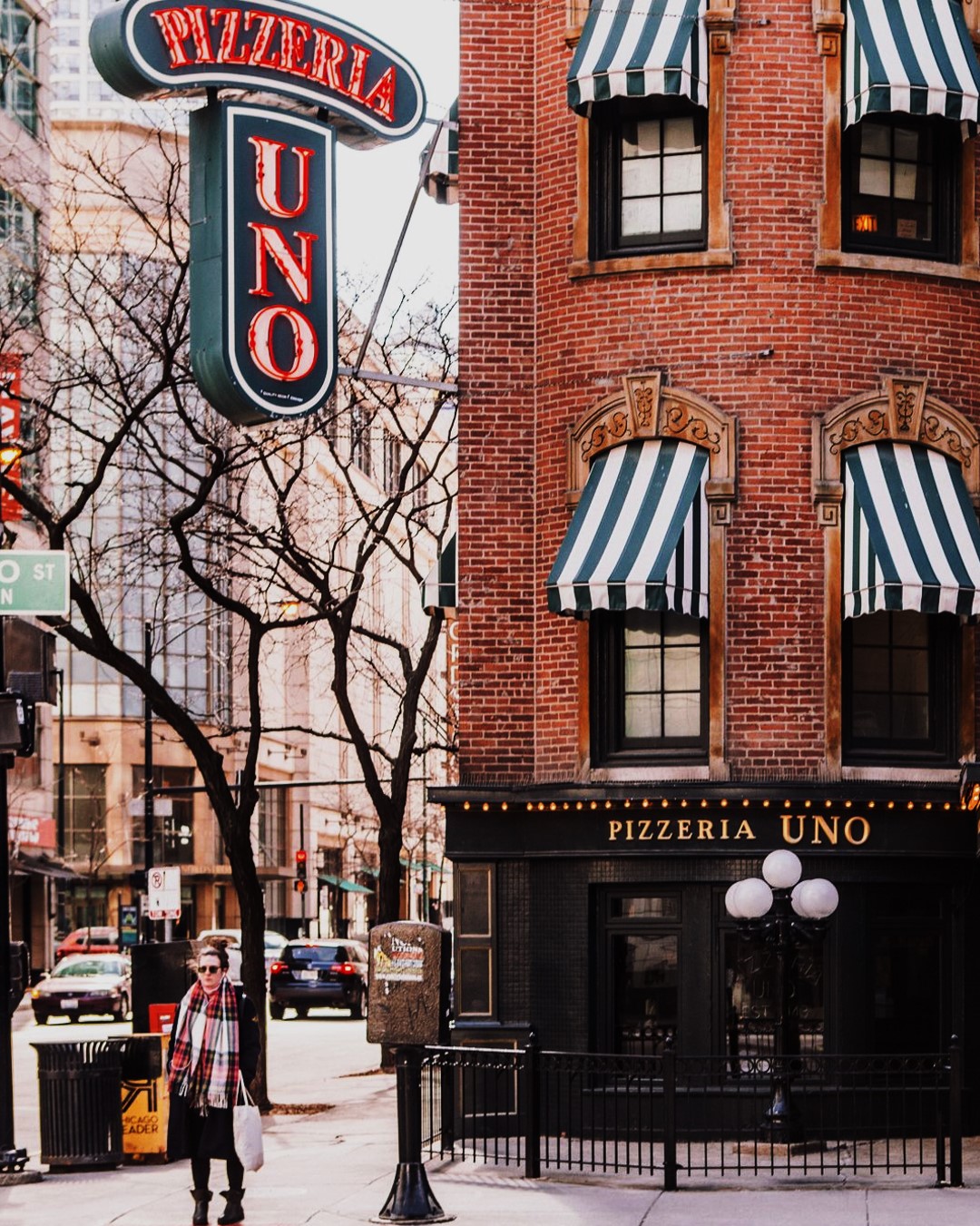
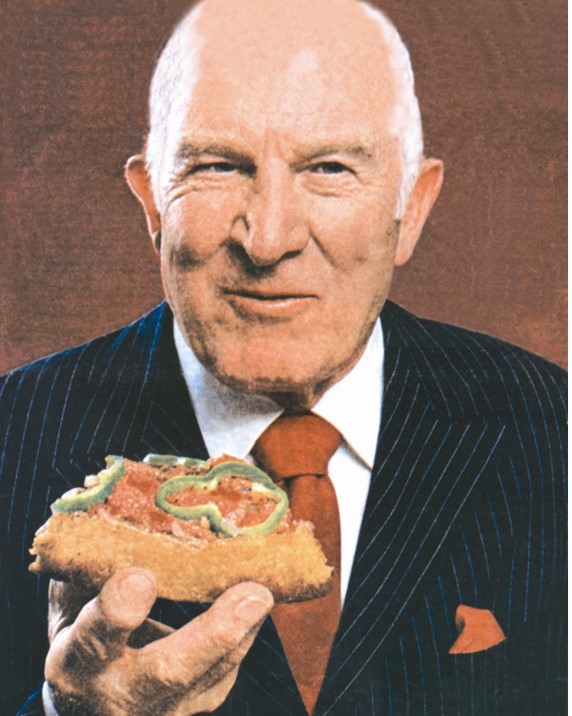
Photo Credit: Uno PIzzeria
There are competing claims from the Malnati family. Rudy Malnati Sr. and Lou both worked at the original restaurant, but there is no evidence of their employment there until Rudy Sr. started there as bar manager in 1951. Lou would leave in 1971 to found Lou Malnati’s. Rudy Malnati Junior went on to found Pizano’s in 1991. The Pizano’s website still states that his father founded Pizzeria Uno in 1943, but stops short of claiming he invented deep dish.
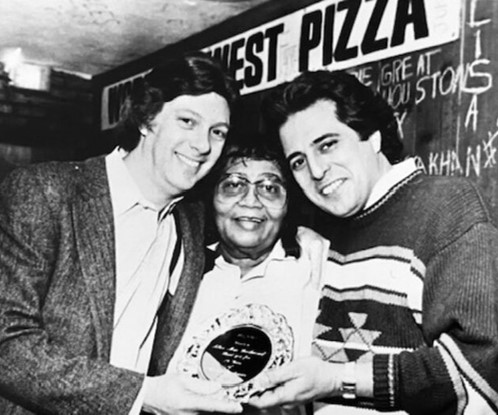
Photo Credit: johnkassnews.com
It seems credit for deep dish as we recognize it today should go to Alice Mae Redmond, a woman from Mississippi who relocated to Chicago and started as a cook at Pizzeria Riccardo in the late 1940s. To make the dough easier to stretch up the sides of the pan, she made it more like a biscuit dough recipe.
By 1960, she was working in the kitchen at Due and at the nearby pizzeria Gino’s opened by cab drivers Sam Levine and Fred Bartoli with their friend George Loverde. When Rudy Sr caught wind that she was working at both, he made her choose, and left them to work at Gino’s. She moved over to Gino’s East when it opened in 1966.
It is also noteworthy that it is here that cornmeal was added to the dough. The restaurant was sold and corporatized in 1983, with additional locations popping up around the city. As these things tend to go, ingredients changed and quality suffered. In 2013, Fred Bartoli’s grandson decided to do something about that, opening Bartoli’s and serving the original Gino’s East recipes from the 1970’s. They’ve gone on to become one of the city’s favorite pizzerias.
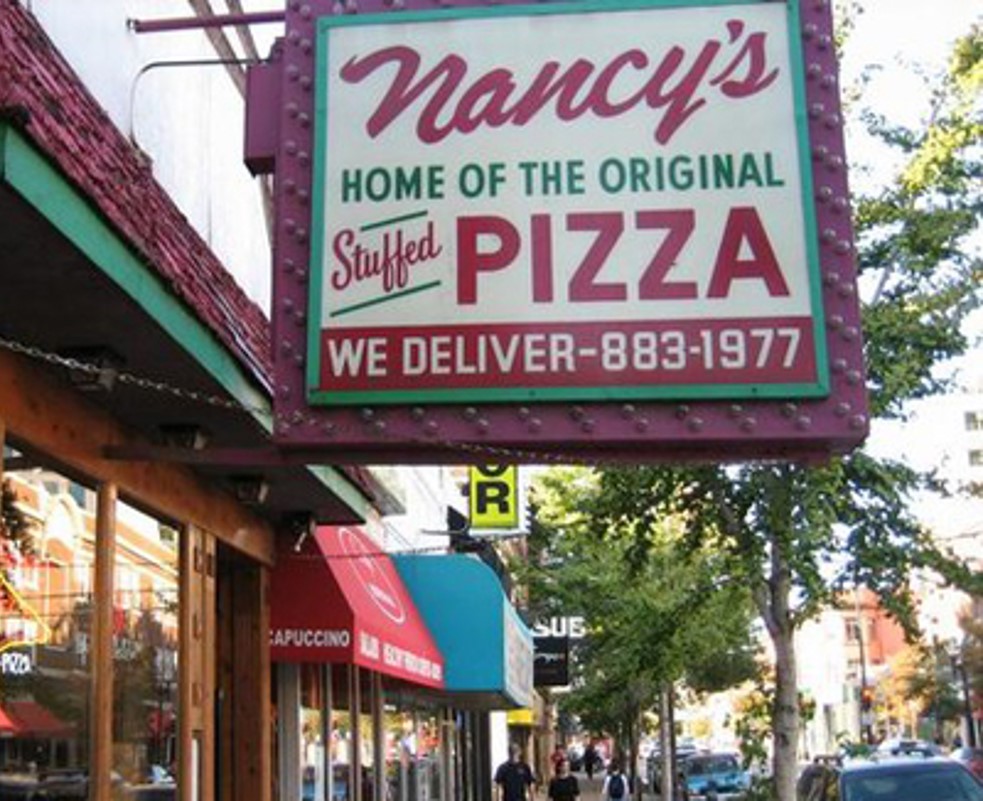
Photo Credit: chicago.eater.com
Through the 1960’s and 1970’s the deep dish arms race kicked off. This is when they became deeper and deeper, as operators tried to outdo each other, leading to the height we are familiar with today.
This culminated in 1974, when Giordano’s and Nancy’s both “ invented” the new deep dish style called stuffed. Rocco Palese, founder of Nancy’s, claimed to have been serving stuffed pizza at another pizzeria for years when the first Giordano’s opened. In response, he opened Nancy’s, named for his wife, and tried unsuccessfully in court to make Giordano’s drop their claim of being the first. Giordano’s currently operates 65 stores nationwide, and Nancy’s 27.
Nancy’s was the target of one of the most intriguing series of events in pizza history in the early 1980’s. The Palese family had sold franchise rights to two locations to the Cirrincione family. When a new Nancy’s opened nearby by the Palese family proved to be too much competition.
"The Cirrinciones poured two gallons of gasoline through a rear window and tried to burn it down. When it reopened two years later, they arranged for an employee to blow it up and burn down another Nancy's location".
In 1963, Burt Katz became a partner in a pizzeria called The Inferno. This is where he introduced his style of deep pan pizza with a caramelized cheese crust that would become famous at his later pizzeria, Pequod’s in Morton Grove. He sold Pequod’s in 1985 and after some time off, founded Burt’s Place in 1989, which he ran until he had to shut due to poor health in 2015. Burt’s achieved worldwide fame after being featured on Anthony Bourdain’s No Reservations in 2009 and went on to be recognized as one of the best pizzerias in the country.
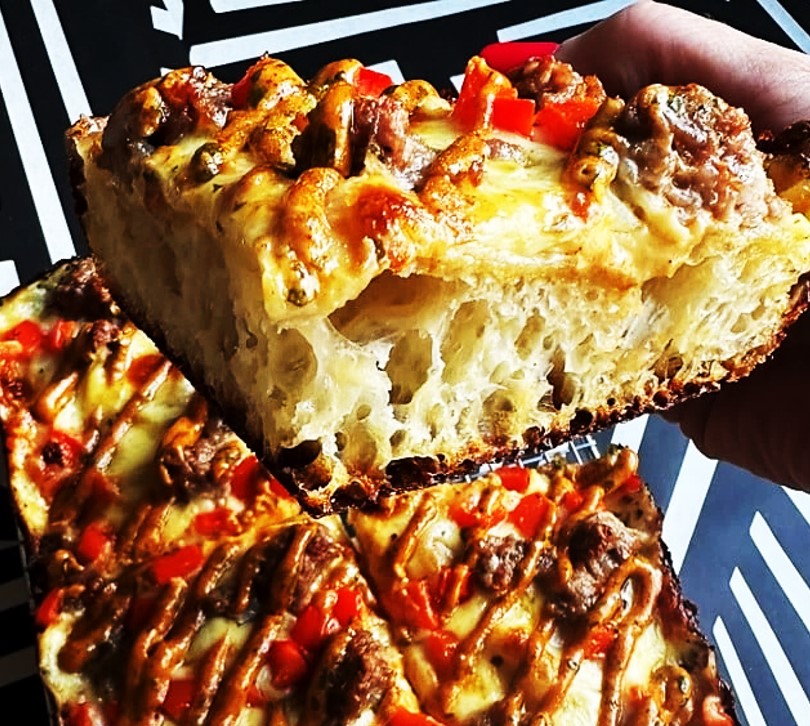
But What About Detroit Style?
Detroit style is a pan pizza.
In some markets it has been incorrectly labelled deep dish for marketing purposes or by food writers who don’t know their stuff.
It’s deeper than a lot of other styles, but following that logic, we would need to call Pizza Hut deep dish, and I don’t think anyone is up for that.
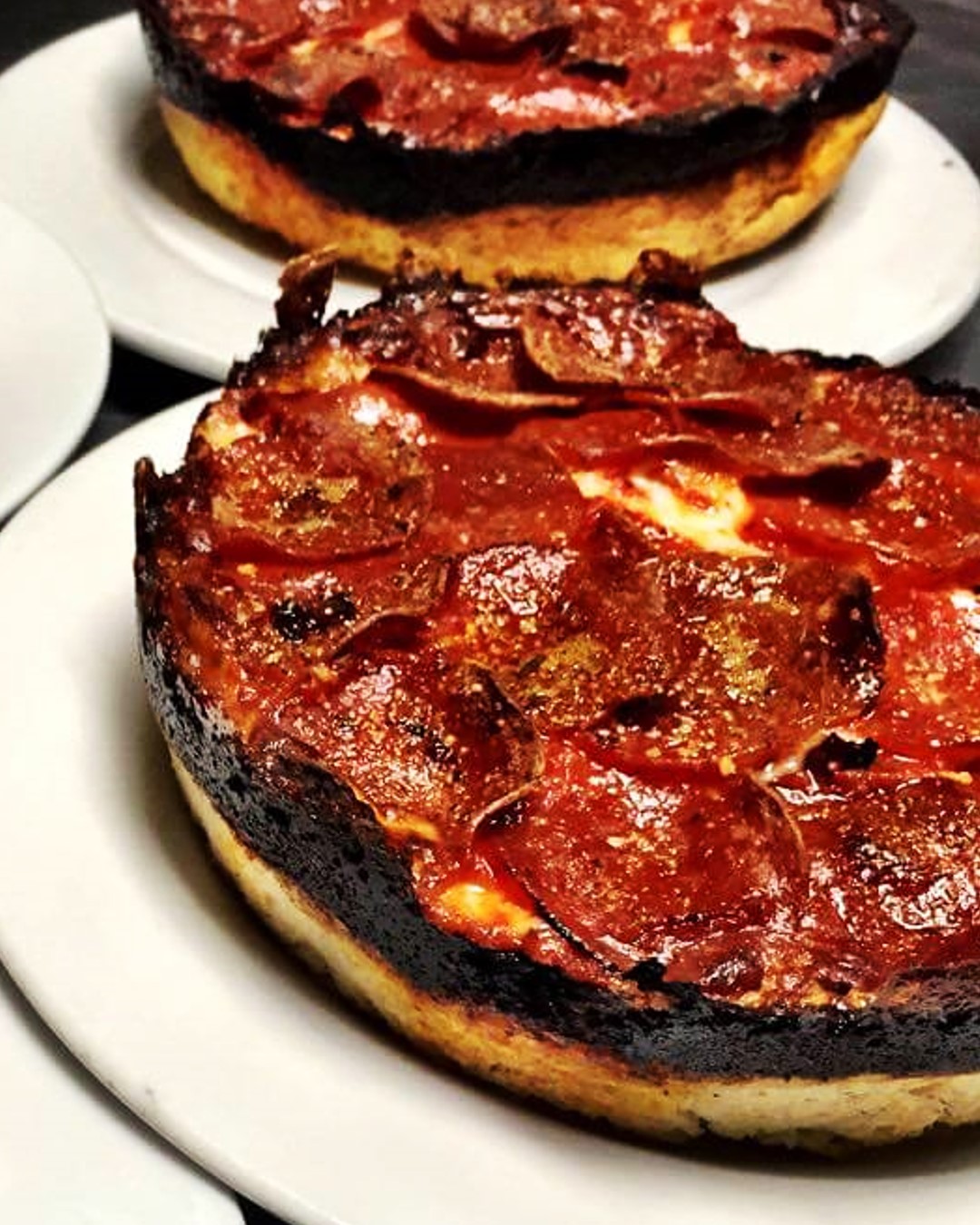
Photo Credit: @pequodspizza
Why Do You Serve Both Stuffed & Pequod's Styles at Deep End?
Well, nostalgia mainly. Back in my uni days in the late 90’s, when my friends and I went out for deep dish we would always go for stuffed. For that reason, it was the deep dish style I would always tinker with when making one at home.
It wasn’t until well into adulthood that I tried Pequod’s for the first time, but it quickly became my new favorite deep dish style.
In recent years, this has finally started spinning off into its own thing in Chicago, with places like Labriola and Milly’s Pizza in the Pan popping up serving great pies based on those Burt Katz dished up at various places for 40+ years.
I think I love it for many of the same reasons I love Detroit style. It’s got the lighter, fluffier base and that caramelized cheese rim, but everything is just more.
"Think of it as Detroit style on steroids".
The Fundamental Divide
When guests ask why our Chicago Stuffed Deep Dish takes 40 minutes and only comes as whole pies, while our Pequod's-style can be served by the slice in minutes, they're witnessing the result of two completely different engineering approaches to the same challenge: how to build a pizza that's more meal than snack.
Why Our Stuffed Must Be Served As Whole Pies
The Cheese Factor: Our 10" large cheese stuffed pizza contains 700g of cheese. When that cheese is molten and distributed throughout the pie's interior, presenting individual slices becomes untenable. The cheese would ooze out, collapsing the structure of the slice and the remaining pie.
Why Our Pequod's Style Can Be Served By The Slice
The Crust Structure: The inverted ratio of crust to toppings creates something that can hold together as an individual slice.
The Caramelized Edge: Here's where Burt's genius shows. Cheese is placed around the rim of the pan, where it caramelizes against the hot pan. This creates a crispy, structural edge that actually strengthens each slice. What looks "burnt" to newcomers is actually a flavor and structural enhancement.
The Visual Difference
The Stuffed Deep Dish Appearance:
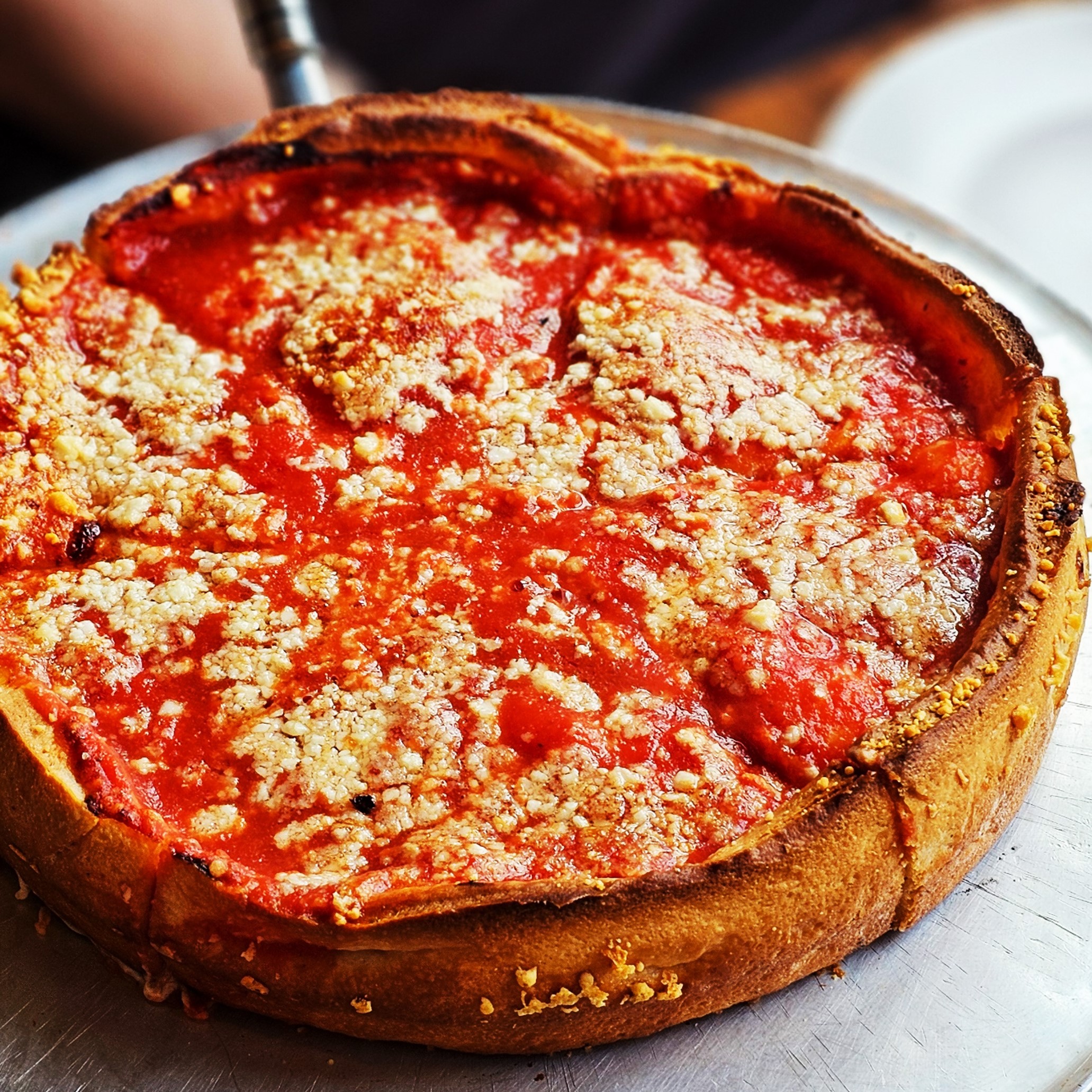
Photo Credit @2goodforks_
- Tall, pie-like structure (2.25 inches thick)
- Smooth sauce top covering the upper crust
- No visible cheese until cut open
- Easier to enjoy with a knife & fork
Pequod's-Style Appearance:
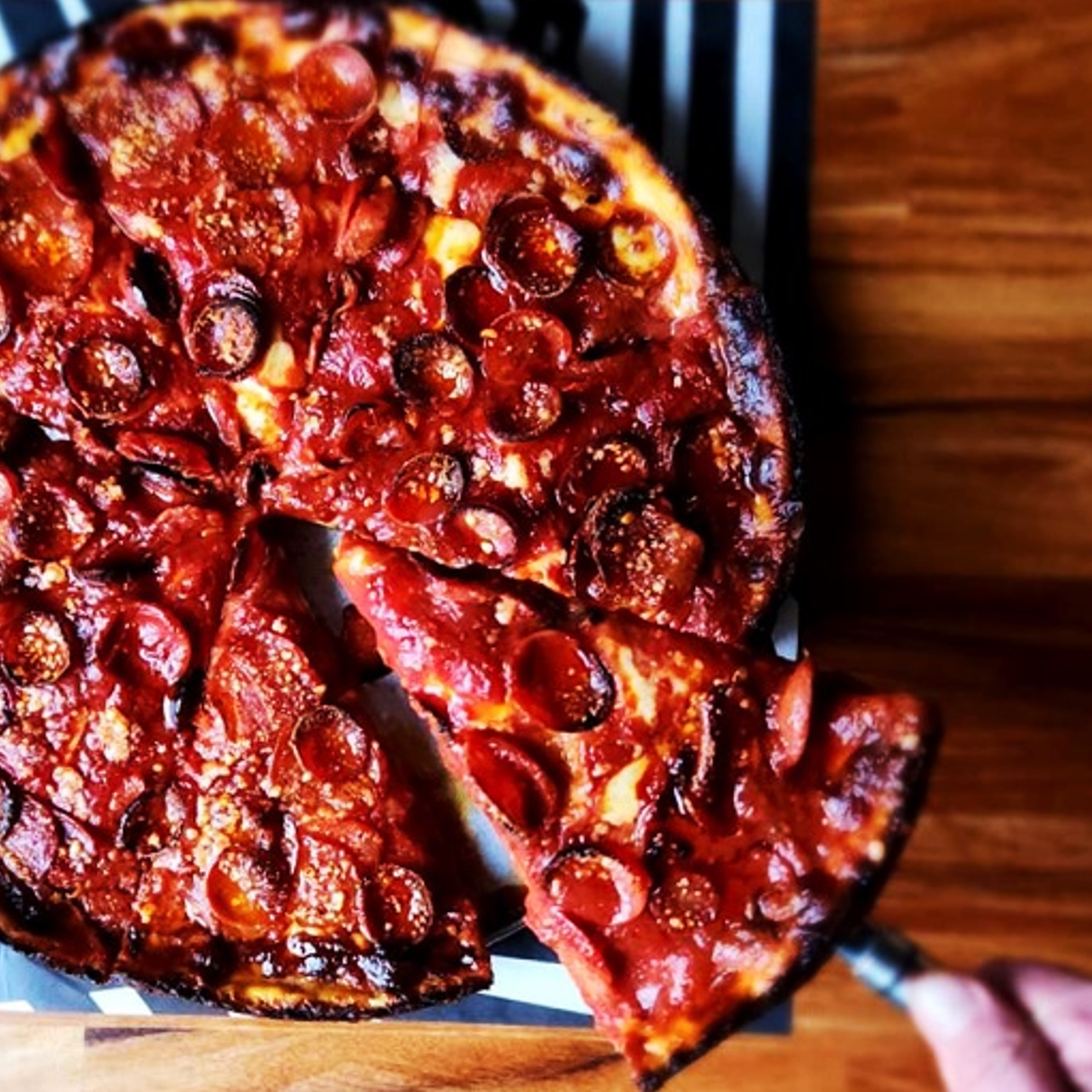
Photo Credit @pkasten
- Dark, caramelized cheese ring around the edge
- Traditional deep dish height but with visible crust character
- The "burnt" look that actually indicates perfect execution
- Sturdy enough for hand-held eating
The Science Behind The Styles
Temperature Management: Stuffed deep dish requires lower, longer heat to ensure the massive cheese load melts completely without burning the top crust. Pequod's-style needs higher heat to achieve that caramelized edge and optimal oven spring in the crust.
Cheese Behavior: In stuffed style, cheese is protected and contained—it melts within its dough envelope. In Pequod's-style, cheese is deliberately exposed to direct heat at the edges, creating entirely different textures and flavors.
Dough Science: Stuffed deep dish dough needs to be pliable enough to create thin top layers but strong enough to support massive weight. Pequod's-style dough needs to be more bread-like—sturdy enough to maintain slice integrity while still achieving that perfect chew.
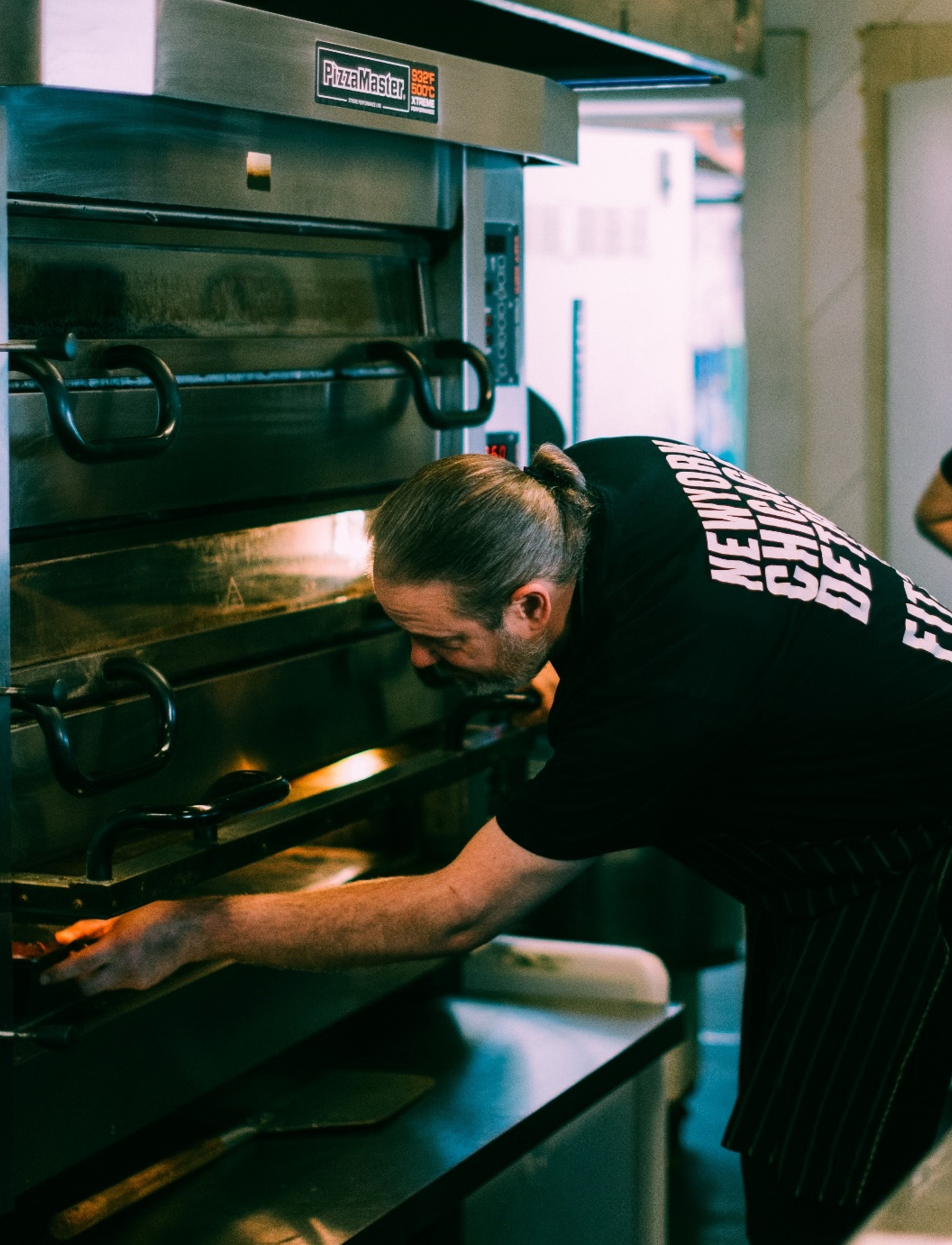
Photo Credit Hayden Dib
The Deep End Committment
At Deep End Pizza, we don't take shortcuts with either style. Our stuffed deep dish requires the full 40-minute preparation time because rushing the process means failure.
Our Pequod's-style demands precise temperature control because that caramelized edge and perfectly crisped base are the difference between just making pizza and honoring Burt Katz's legacy.
When you order our Chicago Stuffed Deep Dish, you're not just getting a large pizza—you're getting edible architecture that can only exist as a complete structure.
When you grab a slice of our Pequod's-style, you're experiencing a different kind of mastery: the precision required to create controlled caramelization and optimal finished moisture/texture in the toppings while maintaining perfect slice integrity.
The Bottom Line
These aren't just menu options—they're two completely different pizza philosophies.
Different histories. Different doughs. Different methods. Different ovens. Different pans.
Both styles honor their Chicago origins while serving completely different needs. Sometimes you want the full ceremony of a stuffed deep dish shared among friends. Sometimes you want the immediate satisfaction of a perfectly engineered Pequod's-style slice.
At Deep End Pizza, we believe you shouldn't have to choose between traditions. That's why we've mastered these two faces of deep dish, honoring the techniques that made Chicago a beacon of pizza innovation.
Want to learn more about the legendary pizzerias that inspired these techniques? Read my complete breakdown in "Mastering Chicago's Deep Dish Legends" for the full story of how these styles evolved from Chicago's greatest pizza masters.



